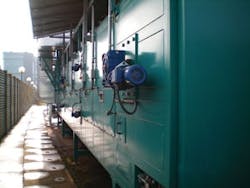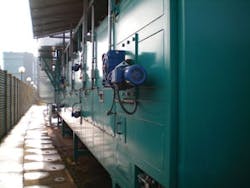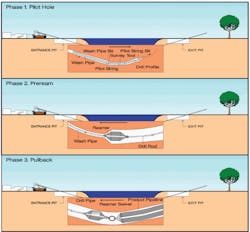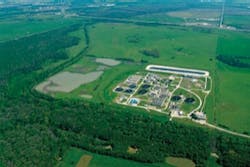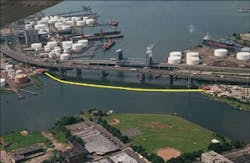By James A. Platosh
The Connecticut Department of Transportation (ConnDOT) recently initiated a massive, $2 billion program to reconstruct and widen 13 miles of I-95 between West Haven and Branford, CT. The centerpiece of the project, known as the New Haven Crossing Corridor Improvement Program, is the replacement of the I-95 Pearl Harbor Memorial Bridge (the Q Bridge) over the Quinnipiac River.
Located immediately adjacent to the existing structure and buried below only a few feet of sediment were twin ductile iron pipe (DIP) sewage force mains, vintage 1980s. The location and shallow depth of the DIP mains made them susceptible to damage as pilings for the work platforms, piers, and barges are driven into the river bottom. In addition, the two mains were located in a predicted scour hole for the new bridge replacement. The force mains convey an average daily flow of 20 million gallons a day and a maximum of 60 mgd during wet weather flows. Loss of the pipes due to construction damage or river scour would have had severe environmental effects on New Haven Harbor's commercial, recreational, and agricultural industries.
Pipeline Relocation
The design team elected to replace the aging force mains with twin 48-inch outer diameter (42-inch inner diameter) High Density Polyethylene pipe (HDPE) to be installed across 1,900 linear feet of New Haven Harbor. The pipeline relocation alignment was severely congested with the I-95 bridge foundations, remains of the adjacent historic Yale Boathouse, fuel pipelines, tank farms, an active concrete plant, pile-supported electrical transmission towers, and the existing active twin force mains.
The fusing operations were conducted on the west side of the harbor on the property of the busy concrete plant and under the existing bridge. The HDPE pipe sections were welded into three continuous 600-foot-long pipe segments. The three HDPE lines were then floated across the harbor the day before the pipe pull and fused during the pull for each of the bores. This technique made it unnecessary to suspend the pipe string above the material storage yard and buildings of the concrete plant which would have required a pullback to the east shore. There were also environmental difficulties, including strong tidal currents, coordination with several agencies for pipeline floatation in the busy harbor, and zero tolerance of environmental impacts to water quality and harbor shellfish bed leases.
Trenchless Technology
Geotechnical aspects of the planned HDD installation required detailed landside and offshore subsurface exploration and analysis to develop a feasible trenchless design. One of the biggest challenges in performing the HDD installation was the continuous, nearly 45-degree turn in the horizontal alignment for both crossings over a length of approximately 1,900 feet with a 60-inch borehole. The constant horizontal curve, creating compound curves when combined with vertical bends in and out of the crossing and rock formation, made for an exceptionally tight fit by "threading the needle" during the pilot hole.
The use of trenchless technology was critical to the success of the operation. HDD was chosen because it was the least disruptive to the sensitive environmental conditions and because of the variable nature of conditions along the drill path. The subsurface conditions that were encountered along the alignment included concrete waste-mixed fill; a high groundwater table; very loose, soft, saturated organic silt layer; low confining pressure at shoreline obstructions; mixed-face soil and rock transitions; a steep rock face; and 15-degree dipping sandstone beds.
HDPE pipe during pull-back installation operation at the east shoreline pit filled with drilling fluids.
The highly variable soil conditions were susceptible to potential hydraulic fracturing and drilling mud discharges because the soil strength was insufficient to resist the slurry pressures applied to using HDD methods. The contractor was responsible for carefully monitoring and controlling drilling fluid weight and fluid pressures to reduce the risk of fracturing the ground and the discharge of slurry onto the ground surface or harbor bottom along the pipeline alignment. He also was required to design and implement HDD construction procedures to reduce potential, inadvertent mud returns into the harbor and onto the ground surface. The directional drill process of creating a pilot borehold using a steerable mechanical drill head to meet the complex geometry of the proposed alignment and the variable nature of the conditions along the drill path of the force mains provided an advantage over other technologies.
Bathymetry, tidal scour patterns and colonial-era wooden fragment subsurface obstructions were identified in the field investigation using offshore borings, sidescan sonar and ground-penetrating radar. Risk mitigations included a geotechnical baseline, HDD contractor prequalification, and a safe drilling target of flowable fill in the debris-laden landside areas. The project required detailed contingency plans within the environmental permit to authorize immediate response to potential inadvertent returns.
Pipe Fusion Issues
For pipe fusion Quality Assurance purposes, ultrasonic testing (UT) was required for all butt fusion welds used to join the HDPE pipe sections into the pipeline segments. Time of Flight Diffraction (TOFD) techniques, using an amplified high-gain probe were employed to generate calibrated signals. Field validations confirmed the effectiveness of the technique for testing thick-walled HDPE materials to identify defect dimensions less than five percent of wall thickness required to maintain pipe material warrantees.
A total of three defects were identified from among nearly 100 fusion joints representing more than 400 square feet of fusion surface area. The UT method provided timely confirmation of fusion integrity where the consequences of repairing a fusion defect during or after installation were extremely acute.
Controlling the Flow
The confluence of the Quinnipiac and Mill Rivers into New Haven Harbor created rapidly flowing currents amplified by seven-foot tides. The combination of flows from the watersheds of the two rivers and storm surge events from Long Island Sound created a potential hazard for the new and existing structures.
After assessing the risk, the design team created a two-dimensional, hydrodynamic computer program and performed simulations for the 50-, 100-, and 500-year peak discharges from the watershed flowing against peak storm tides and surges. Additional models were developed to determine hydraulic design parameters for a scenario combining the proposed design with the temporary trestle and the existing bridge substructure. The hydraulic analysis also included the Tomlinson Bridge which is located immediately downstream of the new bridge. The results of the hydraulic analysis were used to evaluate potential scour at the proposed piers
Environmental Protection
The project was governed by strict environmental limitations regarding the return of inadvertent drilling fluid to the harbor bottom since such a release could affect native shellfish populations. As a consequence, drilling pressure had to be monitored closely. In addition, the soft soils on the western shore of the harbor and the undulations in the rock stratum made it necessary to employ a patient approach to the drilling and reaming process. Extensive engineering controls, close monitoring, and containment/cleanup plans were used to complete the crossings.
During the first HDD crossing there were two minor inadvertent returns to the surface. They were responded to immediately by the HDD contractor, invoking contingency plans and pre-approved, on-hand response equipment in coordination with personnel from ConnDOT and the Connecticut Department of Environmental Protection. The remedies included spill curtains, vacuum pumps, conductor casing and HDD pit modifications. Drilling fluid injections were terminated until containment was completed and modifications to the drilling technique were implemented.
Drilling techniques refined from the first bore allowed the second crossing to be completed without any inadvertent returns. Some increases in pullback force due to ballast irregularities were observed in the rock formation and promptly modified.
Aerial view showing the location of entrance and exit pits and proposed HDD alignment in relationship to Pearl Harbor Memorial Bridge (Q Bridge) and transmission towers.
Bridge Construction Proceeds
Today, as construction of the Q Bridge proceeds, the new force mains continue to convey sewage to the East Shore Treatment Plant from most of New Haven, Hamden, and Woodbridge, along with a portion of East Haven. The piping is outside of the work area for the bridge, nullifying the risk of accidental damage and sewage release. The compound geometry, with a 45-degree bend in a 60-inch borehole in rock, is believed to be a record drill for the industry. The use of a thorough risk assessment during design, combined with a methodical installation by the HDD contractor serves as a model for HDD installation in high-risk locations. WW
About the Author:
James Platosh is a Senior Project Manager with URS Corp. in Rocky Hill, CT. He is a registered Professional Engineer and is a member of the American Society of Civil Engineers. He has worked for URS for 25 years where he is responsible for the management and technical execution of transportation projects.
More WaterWorld Current Issue Articles
More WaterWorld Archives Issue Articles
